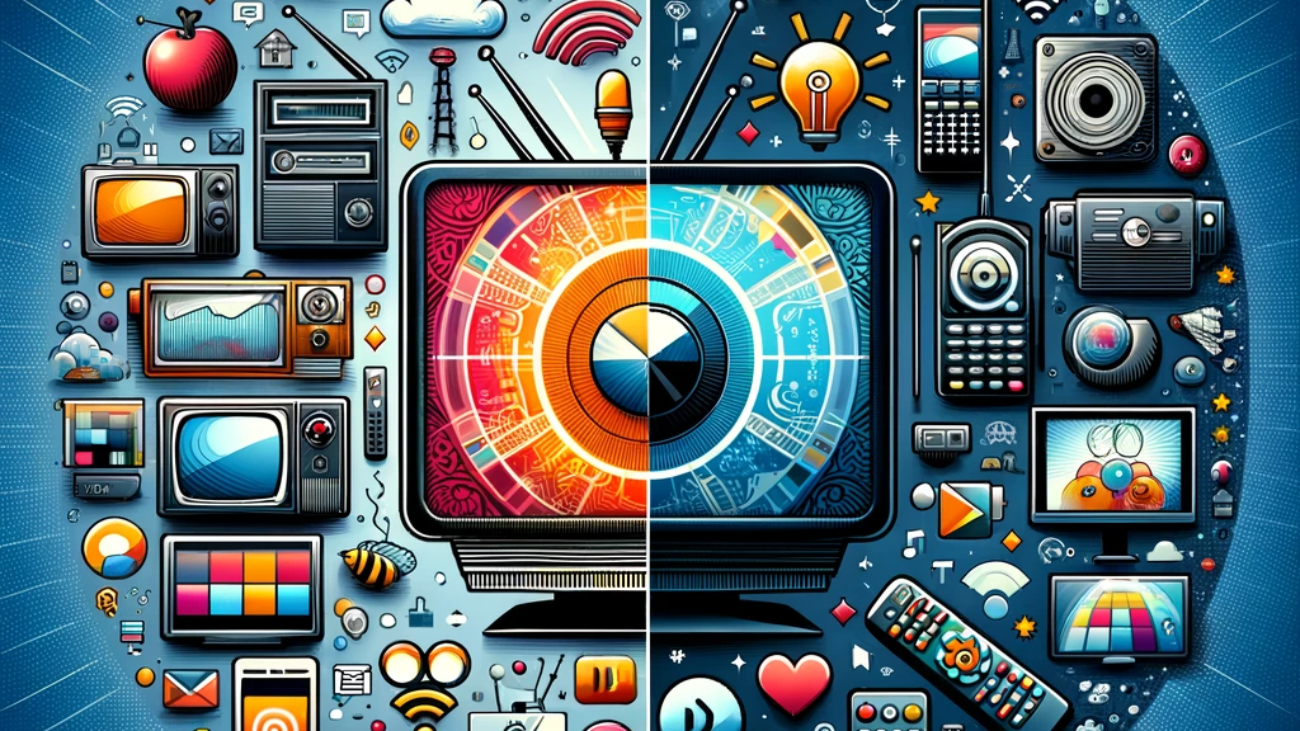Introduction to Traditional TV and OTT
The entertainment industry has undergone a significant transformation with the advent of Over-The-Top (OTT) platforms, creating a riveting dynamic against the backdrop of traditional TV (television). This shift marks not just a technological evolution but also a change in viewer habits, content consumption, and the very definition of television as we know it.
Evolution of Television Entertainment
The Rise of Traditional TV
Traditional TV, an integral part of households for decades, has played a pivotal role in shaping our cultural and social fabric. Its journey from analog to digital broadcasts reflects the technological milestones of our times.
The Advent of OTT Platforms
In contrast, OTT platforms emerged as a digital revolution, breaking free from the constraints of scheduled programming and geographical boundaries. This new medium brought with it a wave of personalized, on-demand content.

Understanding Traditional TV
Definition and Mechanics
Traditional TV operates through broadcasting signals, be it via cable, satellite, or antenna. It’s characterized by a fixed programming schedule, offering viewers a pre-determined slate of content.
Key Features of Traditional Television
Traditional TV is synonymous with live events, news broadcasts, and a communal viewing experience. It stands as a testament to a shared, collective media consumption practice.

Exploring OTT Platforms
What is OTT?
OTT platforms stream content over the internet, bypassing traditional broadcast methods. These services have redefined convenience, offering viewers a buffet of content choices accessible anytime.
How OTT is Reshaping Entertainment
OTT platforms have disrupted the traditional TV model by offering flexibility, diversity in content, and a personalized user experience, reshaping how we perceive and consume entertainment.
Content Comparison: TV and OTT
Variety and Depth in Programming: While traditional TV offers a range of channels and genres, OTT platforms boast an expansive library of global content, including niche and specialized programming.
Original Content and Syndicated Shows: OTT platforms have become powerhouses of original content, while traditional TV often banks on familiar, tried-and-tested shows and formats.
Accessibility and Convenience
On-Demand vs. Scheduled Viewing
The on-demand nature of OTT platforms starkly contrasts with the scheduled programming of traditional TV, offering viewers unparalleled control over their viewing experience.
Device Compatibility and Portability
OTT platforms excel in device compatibility, allowing viewers to stream content on phones, tablets, and smart TVs, unlike traditional TV’s limitation to the television set.
User Experience: Interactivity and Control
Viewer Control on OTT
OTT services offer a high degree of interactivity, from choosing what to watch and when to watch it, to personalized recommendations and seamless multi-device viewing.
Traditional TV’s Linear Approach
In contrast, traditional TV offers a linear viewing experience, where audiences tune in at designated times, adhering to a broadcaster-set schedule.
Cost Analysis: Subscription Models and Pricing
Pay-Per-View vs. Subscription Services
Traditional TV often includes options like pay-per-view for special events, while OTT platforms generally adopt a subscription-based model, offering various tiers and packages.
Financial Implications for Consumers
OTT subscriptions can be more cost-effective and customizable compared to traditional TV’s bundled channel packages, offering consumers more choice and control over expenses.
Impact on Social Viewing Experiences
Community Viewing on Traditional TV:
Traditional TV has long been a catalyst for communal viewing experiences, especially during live events, fostering a sense of shared experience.
Personalized Viewing on OTT:
OTT platforms, while offering personalization, often cater to individualized viewing habits, potentially diminishing the communal aspect of TV watching.
Advertising and Revenue Generation
Commercial Breaks vs. Ad-Free Options
Traditional TV relies on advertising revenue, punctuating programming with commercial breaks. OTT platforms, however, often offer ad-free viewing as part of their subscription packages.
Revenue Models in TV and OTT
The business models of traditional TV and OTT differ significantly, with OTT platforms exploring innovative monetization strategies, including tiered subscriptions and ad-supported content.
Technological Advancements and Future Trends
Smart TVs and Integration
The integration of OTT apps into smart TVs is a game-changer, offering a unified platform that blends traditional TV and streaming services.
Future of Streaming Technologies
Emerging technologies and increasing internet penetration are poised to further boost the growth and evolution of OTT services, potentially leading to more immersive and interactive content experiences.
The Global Reach of OTT and Traditional TV
Regional Availability and Limitations
Traditional TV, constrained by geographical boundaries, contrasts with the global reach of OTT platforms, though they too face challenges with content licensing and regional availability.
Worldwide Audience and Cultural Impact
OTT platforms cater to a global audience, offering diverse content that transcends cultural and linguistic barriers, unlike traditional TV’s regional focus.
Legal and Regulatory Aspects
Content Censorship and Ratings
Traditional TV and OTT platforms navigate a complex web of content censorship and ratings, with regulations varying significantly across regions and platforms.
Copyright Issues in TV and OTT
Navigating copyright laws poses unique challenges for both mediums, particularly for OTT platforms due to their digital nature and global reach.

Consumer Behavior and Preferences
Shifts in Viewing Habits
The rise of OTT platforms has led to a noticeable shift in viewing habits, with consumers increasingly favoring on-demand content and binge-watching.
Audience Demographics and Preferences
OTT platforms tend to attract a younger demographic with their diverse and innovative content offerings, while traditional TV continues to appeal to older audiences and certain niche markets.
Challenges and Limitations
Internet Dependency for OTT
The reliance of OTT platforms on stable internet connectivity is a notable limitation, impacting accessibility in regions with limited internet infrastructure.
Limitations of Traditional Broadcast TV
Traditional TV is constrained by its dependence on broadcast schedules and fixed programming, offering less flexibility in content choice and viewing times.
Traditional TV vs. OTT: The Future
Predictions and Speculations
The future of television lies in a hybrid landscape, where traditional TV and OTT platforms coexist, each adapting to changing consumer preferences and technological advancements.
Adapting to Changing Consumer Needs
The evolution of both mediums will be dictated by their ability to adapt to the evolving needs of viewers, leveraging technology to enhance content delivery and user experience.
FAQs
- What sets OTT platforms apart from traditional television broadcasting? OTT platforms offer on-demand, personalized content that can be accessed on multiple devices. They differ from traditional television, which follows a scheduled programming format and requires a cable or satellite connection.
- In terms of cost, how do OTT platforms compare with traditional TV? OTT platforms typically operate on subscription-based models, which can be more cost-effective compared to traditional TV’s bundled channel packages. OTT offers a variety of content choices at potentially lower costs.
- Is it possible to access live TV on OTT platforms? Yes, some OTT platforms provide access to live TV, offering a mix of live sports, news, and entertainment, similar to traditional TV but over the internet.
- What internet speed is necessary for smooth streaming on OTT services? For standard-definition content, a minimum of 3 Mbps is recommended, while high-definition content requires at least 5 Mbps. For 4K content, speeds of 25 Mbps or higher are ideal.
- Do OTT platforms generally offer higher-quality content than traditional TV? OTT platforms are recognized for their high-quality, original content, often attracting a broad audience with diverse and compelling programming, which competes strongly with traditional TV content.
- Is it likely that OTT platforms will eventually replace traditional TV? While OTT platforms are significantly influencing the entertainment landscape, they are unlikely to completely replace traditional TV shortly. Both mediums are expected to coexist, each serving different audience preferences and needs
Conclusion: The Changing Landscape of TV Entertainment
The tussle between Traditional TV and OTT is a fascinating chapter in the evolution of media consumption. As technology advances and viewer preferences evolve, we are set to witness an even more integrated and diverse entertainment landscape.
Additional Sources:
- “The Future of Television: The Impact of OTT on Video Production Around the World” – Boston Consulting Group: Discusses how OTT platforms are transforming traditional broadcast TV and the entire television and filmed entertainment landscape. Read more
- “The Rise of the OTT Platform and its Impact on the Entertainment Industry by 2040” – Blackcoffer Insights: Explores the rise of OTT platforms and their potential implications by the year 2040. Read more
- “What is OTT? Exploring the Rise of OTT and Its Impacts on the Entertainment Industry” – Castr: Discusses the growth of OTT platforms, their impact on the entertainment industry, and changes in content consumption. Read more
- “OTT Platforms are Winning the War Against Traditional TV in the US” – Business Insider India: This article reports on the increasing dominance of OTT platforms over traditional TV in the United States. Read more

